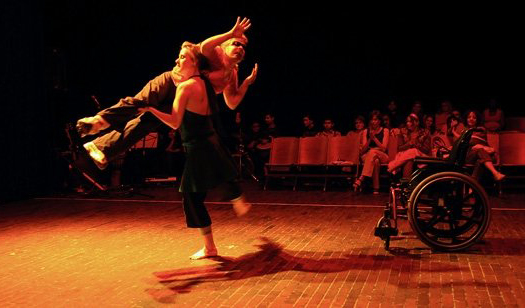Maureen Finnerty relishes the moments in which the audience is shocked by what the performers can do. She cites many instances in which audiences gasped when the performers abandoned pairs of crutches or relinquished their wheelchairs during the performance, “You can sense that people wonder if they should get up and help [the performer]. It’s the fact that they can’t, we’re on stage and that shows people just how much anyone can do.”
Maureen remembers parents who could not have imagined their child as a dancer, students who ask her to call their teachers to explain that they can physically do much more, and students who understand that being stared it can be ok.
“People [are] looking at them, but now it’s for the right reasons.” Indeed, for Maureen the real reward is seeing how the attitudes of the performers change about themselves. The audience’s misinterpretation of the performance’s intent is negligible. “[The students] come away with a different idea about what the pathways for people with disabilities are,” she explains, “the audience will have their own perspective on the performance, and they will have their own perspective on my disability.”
According to performer and movement educator Maureen Finnerty, the audience often misunderstands the performers.
“I’ve had people come up to me after a show and say, ‘Wow. I really loved what that piece said about disability.’ But the piece had nothing to do with disability.” When asked if the audience’s misinterpretation of her students’ performance bothers her, Maureen is quick to explain that, “… we’re giving a present to the audience. Everyone will unwrap it differently.”
For Maureen, the beauty and power the ensemble members bring to their performance stems from their personal investment in the roles they craft. She says the investment happens because the students at Access to Theater are never told their characters. “We choose [our character] and through rehearsals [we learn] the impact of our words and movement before we’ve even performed it.”
And the end result? “The parents always cry. I don’t get it,” she laughs.
Despite her self-assured way of talking about her experience as a performer and an educator, Maureen was not always comfortable in the realm of creative movement. Only after joining Access to Theater at a friend’s suggestion did Maureen begin to explore movement as a form of self-expression.
“My only idea about movement came from my physical therapy,” she explains, recalling her initial hesitation to learn movement techniques. “When I started [at Access to Theater] I realized [movement] was no longer a painful thing I did for physical therapy. It could be beautiful.”
Through many years as a student, an intern, and now a staff member at Access to Theater, Maureen has come to see movement as a tool for self-discovery. “It helps people accept who they are. [Access to Theater] gave them confidence.”
As the Movement Director for Partners’ for Youth with Disabilities’ Access to Theater Program, Maureen Finnerty teaches children and adults with and without disabilities that “everyone has a place in theater and that each person enriches the creative process when he/she keeps an opened mind.” She has been a resident artist for VSA Massachusetts for seven years and has assisted with workshops that focus on teaching the elements of improvisational theater to participants of all ages and abilities; included in these workshops has been the concept of access for all through universal design. She also performs in community movement productions.

